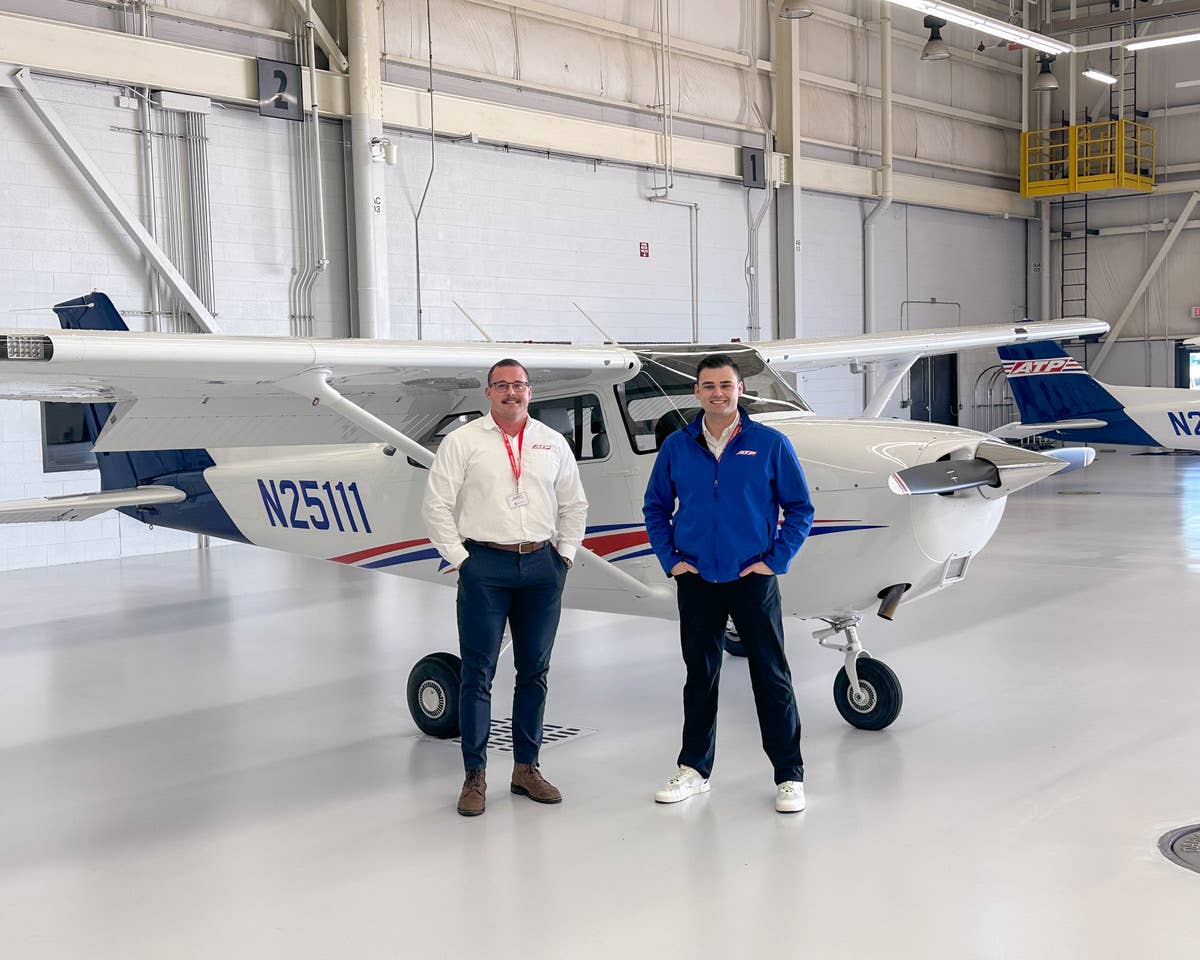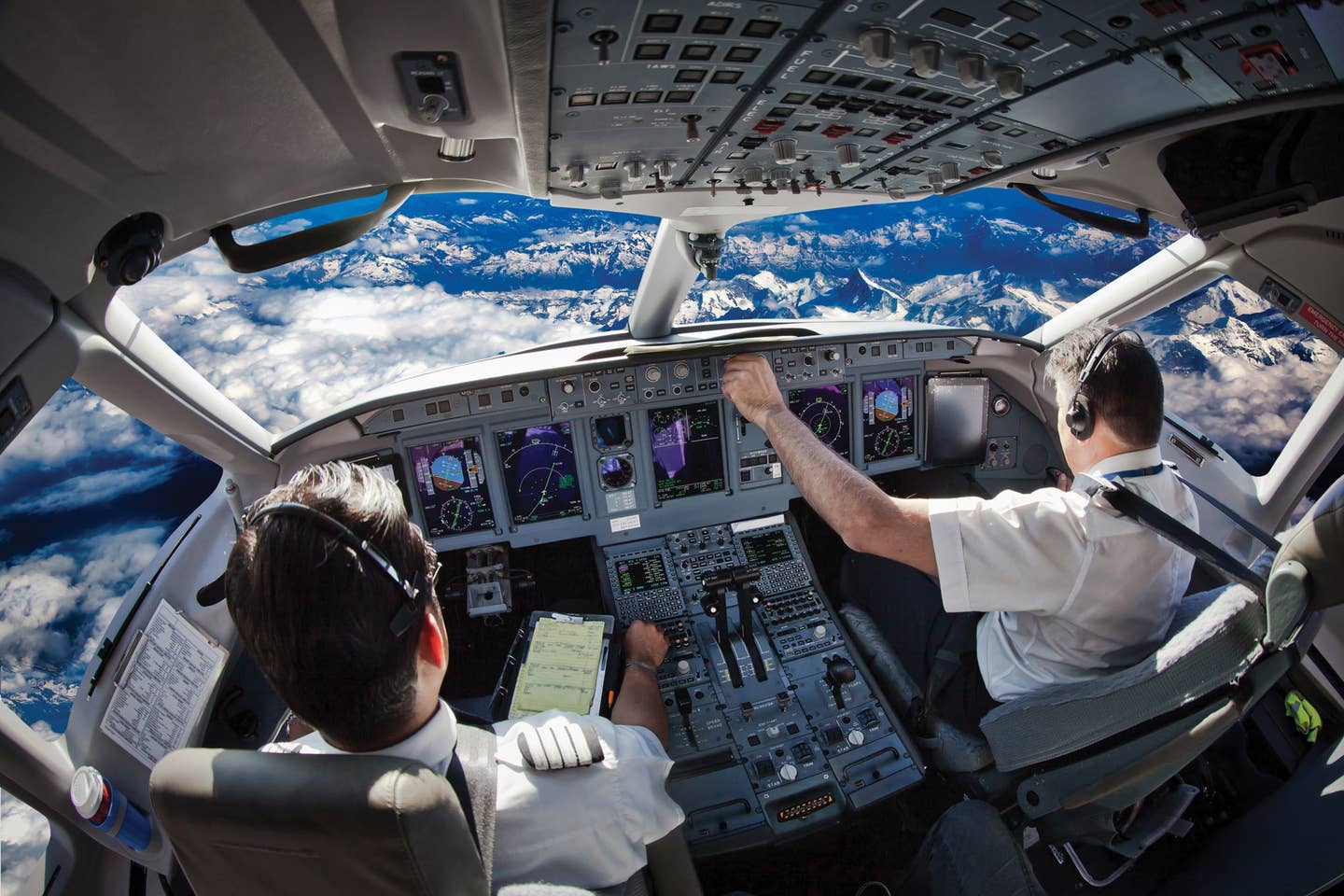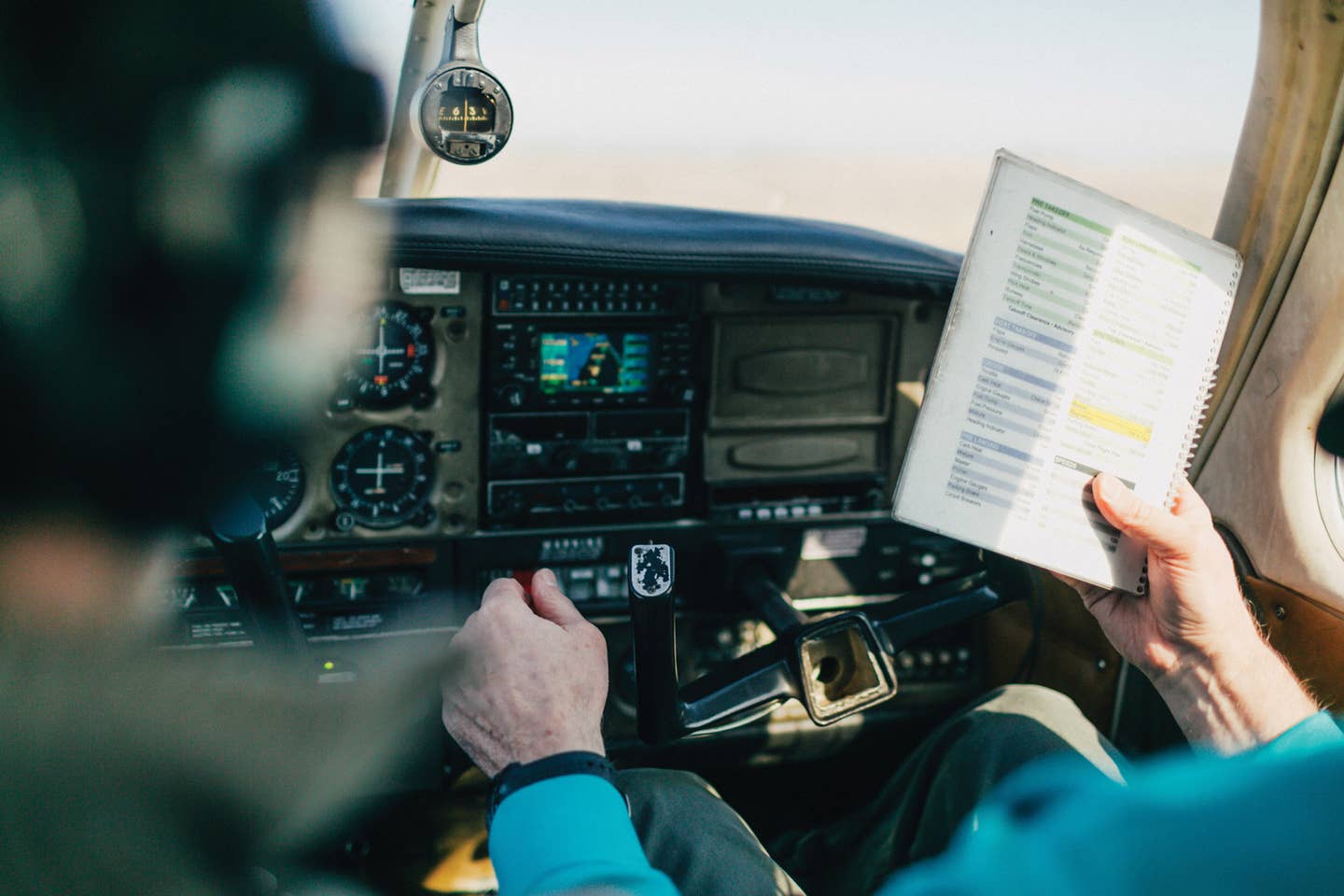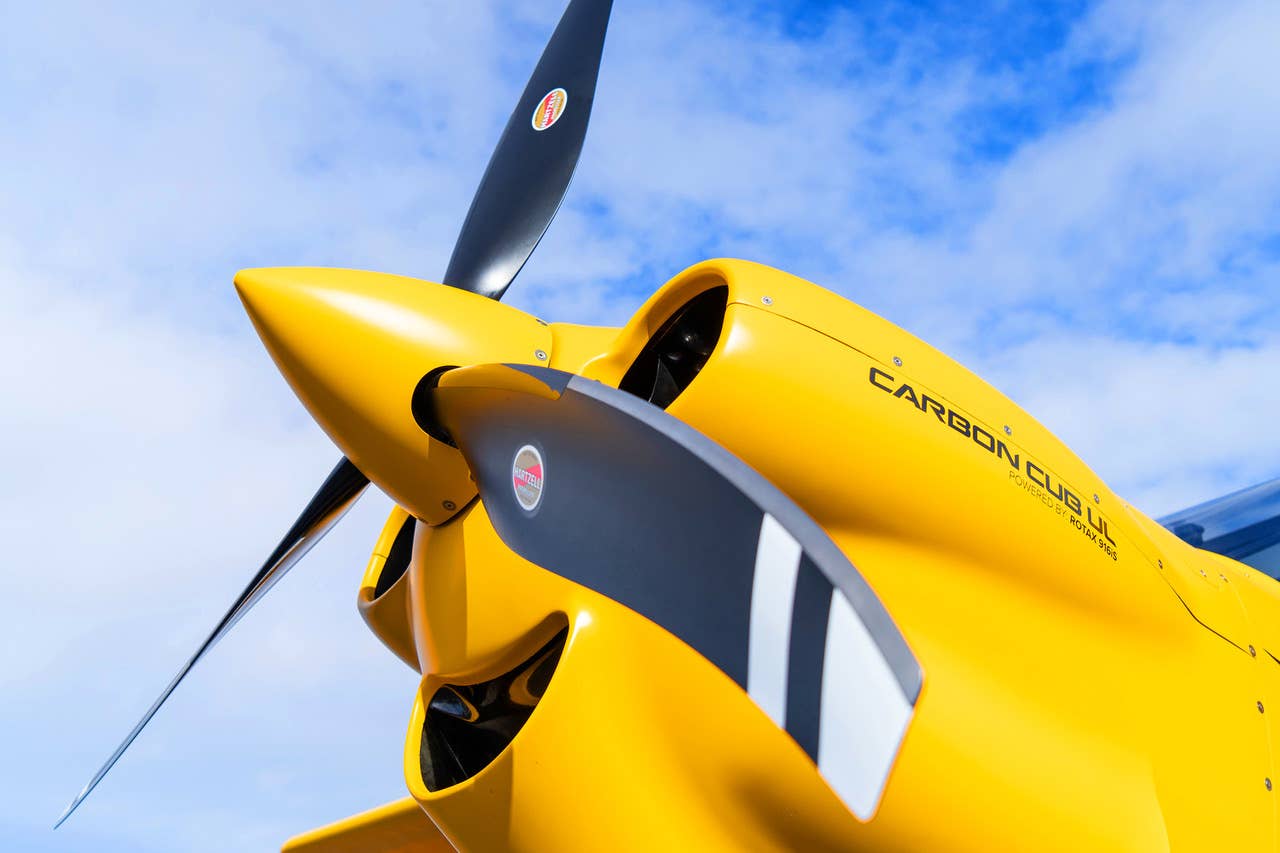20 Things You Never Knew About Your Airplane (Or Someone Else‘s)
A few little known thoughts. Ever heard of the Cessna 620? Why T-tails? A Seneca Tri-Motor?
 Skyhawk |
1 Beech Barons have always been among the best-handling twins in the sky, but they did have a curious anomaly. The throttles were mounted in the middle between the props and the mixtures. This could've resulted in pilots trained in conventional twins accidentally feathering both props on short final. Many pilots never understood why Beech opted for this seemingly nonstandard placement, but the answer was actually fairly simple. It was a carryover from the Beech 18 of the '40s and '50s. Those airplanes were often flown with a copilot in the right seat. Beech positioned the throttles in the middle so either pilot could reach them with equal facility. Barons didn't share the commercial application, but Beech continued the throttle placement in the middle on the models 55 and 58 anyway. (The company eventually made the argument that it was the rest of the world that was out of step and moved the throttles to the far left on the 58 Baron.)
2 The reality is that Skyhawks are forever, unchanging, gentle to a fault, capable, everyone's friend. The myth is that there were only two or three versions of the Skyhawk built. Depending upon how you count them, there were actually seven variations on the 172 theme. The first 145 hp Continental-powered Skyhawks were introduced in 1958 (1) along with the Cessna 175s, a 175 hp, geared version of the same airframe and wing (2). In 1968, Cessna switched to a cambered wing on the 172M (3). The Hawk XP was introduced in 1977 with an injected 195 hp Continental and a constant speed prop (4). Cessna's Cutlass RG debuted in 1980 with retractable gear and a 180 hp Lycoming IO-360 engine (5). A fixed-gear version of the airplane was introduced in 1983, and that model (6), along with the standard 160 hp version, continued in production until three years ago, when all Skyhawks were standardized as the 172SP (7) with the 180 hp injected Lycoming. In other words, there have been seven variations of the Skyhawk in the last 56 years, and a diesel-powered model may still be in the offing.
 Marchetti |
3 I first flew a SIAI-Marchetti SF.260 20 years ago in conjunction with a pilot report for this magazine. The airplane was an absolute delight in almost every respect. During that flight and subsequent hops (including a delivery of a pristine example from California to Coventry, England), I learned quite a bit about the airplane and its quirks. Everyone agreed the Marchetti was a remarkable flying airplane, but for reasons only the Italians understood, most SF.260s were fitted with carbureted engines. This meant the airplane had little tolerance for negative Gs or even low positive Gs. Pull a hammerhead stall too steep, and the engine would quit. Similarly, because this was primarily a military trainer, the pilot flew from the right side, and all instruments and radios were biased to that seat. Also, the wing was notoriously intolerant of any contamination---read "icing." On my Atlantic deliver, I was advised by several very experienced Marchetti pilots to avoid icing at all costs. It seems the airfoil that was so perfectly suited for aerobatics and formation work wasn't happy in icing. My ferry flight was in late fall, not the best season to avoid icing, but I managed to steer clear of most frozen sky, ironically picking up a small amount during the final leg into Coventry.
 Mooney |
4 When Piper introduced the Arrow in 1967, the airplane's automatic gear extension system helped it knock Mooney off the pedestal as best-selling retractable. The Arrow featured a simple airspeed switch that automatically lowered the wheels if the airplane subceeded about 80 knots with the gear in the up position. The system was so reliable that it was copied by both Bellanca and Beech. As so often happens with good ideas, the auto-extend system proved to be too good. A pilot ran out of fuel in an early Arrow during a cross-country flight, was gliding toward an airport within easy reach and got a little slow. The gear dropped down obediently, now with no way to get it back up. This compromised the Arrow's glide and caused the airplane to land short. The owner survived and, of course, sued Piper. Piper lost, and that was the end of the auto-extend feature.
5 Depending upon whom you ask, the unusual Cessna Skymaster is either the safest twin above the planet or just another idea that didn't make it. Accident statistics suggest the latter, indicating the same safety record as for many asymmetric-thrust twins. The Cessna 337 was a push-pull multi intended to eliminate asymmetric thrust following an engine failure. The 337 did have a few quirks, however. Incomprehensible as it may sound, a few pilots allowed the rear engine to idle out and initiated takeoff with only the front engine running. Most of these takeoffs didn't work out too well. Another lesser-known glitch had to do with retracting the gear during an engine failure. Counterintuitively, Cessna recommended the gear be left down until the aircraft ascended to a safe altitude. With the well doors open to accept the gear, the resulting belly cavity serves as an air dam that subtracts 240 fpm from climb. True, the gear cycle is probably only 15 seconds or less, and that's fine if you have that much to spare. If you don't !
6Back in the decade surrounding the 1980s, T-tails became something of a trend. Piper embraced T-tails big time, mounting them on their Cheyenne III and IV, Arrow, Lance, Seminole and Tomahawk. Beech adopted them on the Duchess and Skipper, and Bellanca featured a T-tail on its short-lived Aries T-250. Trouble was/is, T-tails aren't ideally suited to all airplanes. Mounting the horizontal stabilizer high on top of the vertical tail can create as many problems as it solves. T-tails typically demand a beefier empennage structure, but can allow the elevator to fly in undisturbed air at low speeds and high angles of attack. On some models, a high tail simply doesn't have the pitch authority it needs, and takeoff and landing distances are extended. Sure enough, Piper reverted to a conventional tail on the Arrow and Lance/Saratoga, and Beech dropped the Duchess and Skipper altogether.
7 Owners of manual-gear Mooneys tend to be fanatical about their compact, little speed demons. It's a fact that the bicep-powered, Johnson-bar, Mooney- gear systems were among the fastest in the industry. A really competent pilot of a 1965 or earlier M20 could lever the wheels into the wells so fast, an outside onlooker could be fooled into thinking the gear had simply disappeared. With the benefit of gravity, extension was even faster. In fact, the Mooney's manual retraction mechanism was the only one certified by the FAA without a backup extension system. Perhaps ironically, Mooney abolished the manual gear system because it was too hard to get up, not down. Back in the '60s, some lightweight pilots complained that manual retraction was simply too physically demanding, and Mooney was forced to switch to an all-electric system that still managed three seconds up and two seconds down---still the fastest in general aviation.
8 Whatever your opinion of the V-tail Bonanza in-flight tail failures, the mechanics of the failures have long since become well known. The last failure occurred in Northern California in April 2002, but the vast majority of the 200-plus accidents have been intimately dissected and analyzed. The FAA finally addressed the problem head-on in 1986 and determined that the leading edge of the ruddervaters was failing when subjected to high loads. The V-tail's leading edge wasn't attached to the fuselage, so any significant load could cause the forward rudder to fail and deflect, precipitating failure of the entire tail and loss of the airplane. The major cause of the accidents that resulted was exactly what made the Bonanza such a wonderful airplane to fly---the delightfully light control response, far superior to that of most airplanes of the time. The answer was a simple cuff to anchor the leading edge to the aft fuselage, so it couldn't deflect with high G-loads.
9 Aerostars were almost universally regarded as the fastest piston production airplanes with any number of engines. Designer Ted Smith was nothing if not eccentric, however. His ultimate piston twin reflected his quirks. Practically everything on the Aerostar was electric, including the fuel selectors. The airplane was fitted with three fuel tanks, 62 gallons in each wing and 41.5 gallons in a fuselage tank mounted in the forward section of the baggage compartment. The fuel selectors had three positions---on, off and crossfeed---and like everything else, they were electrically powered. Turn on the master, flip the selectors to on and you'd hear the telltale "wooo" of the selectors as the valves opened. This would allow the airplane to feed fuel from the center tank to both engines by head pressure. When the center tank reached the same level as the wing tanks, fuel would begin feeding from the wing tank to its respective engine, and the center tank would continue to feed both engines. Problems arose if you were running on double crossfeed and had a total electrical failure. That shut the center tank out of the system completely. If you couldn't get the fuel system back to the normal "On" position, that 41.5 gallons became unavailable. That's why the flight manual had a large red warning in the fuel system section that read, "DO NOT RUN ON DOUBLE CROSSFEED."
10 Just as the relative merits of high wing/low wing have been argued for years, pilots continue to disagree about the benefits of wood versus metal in light-aircraft construction. Wing integrity has been heavily debated between the all-metal and wood wing crowd. Wood wing proponents argue that wood has no memory and therefore doesn't "remember" past overstresses, whereas aluminum can only be stressed so many times before it fails. No less an authority than the late Scott Crossfield, aeronautical engineer, designer and X-15 test pilot with more rocket time than anyone else back in the 1950s, agreed wholeheartedly. "The wing on the Bellanca Viking was built of Sitka spruce, and it was practically indestructible when properly maintained. Wood makes a better surface for shaping airfoils because it may be perfectly contoured to the desired airfoil section without screws, rivets, butt skin lines or other interruptions. Wood airplanes do demand to be kept inside, but they're worth it."
 Questair Venture |
11 Pretty much everyone has heard about the Ford Tri-Motor and the Junkers JU-87 Tri-Motor (in fact, there were nearly 200 tri-motor models produced prior to World War II), but did you know there was also a Piper Seneca Tri-Motor? When Piper was toying with the very first prototype of the Seneca in the 1960s, they tried mounting a pair of 180 hp engines on the wings of a standard Cherokee Six 300, but left the 300 hp Lycoming in place on the nose. Climb performance with 660 hp was spectacular, but no one could figure how to put enough fuel aboard to give the airplane more than a 400 nm range, so Piper killed the three-engine idea.
12 Okay, just to one-up a tri-motor, did you know that Cessna designed and built a prototype for a pressurized four-engine business aircraft in the mid-'50s? The Cessna 620 (310 times 2, get it?) mounted four-geared, 350 hp Continentals on the wings and was planned to be configured for up to 10 passengers. Cessna conceived the design in 1952 and made the first flight four years later, but the timing was wrong. Coincidentally, Cessna also was working on the USAF T-37 jet trainer at the same time, a guaranteed government contract, whereas the 620 had to be funded by Cessna alone. Jets were just coming into service with the airlines, and there was a glut of Martin 404s and Convair 240/340s coming onto the market at low used prices. These carried more passengers and cruised faster. The 620 was abruptly canceled in 1957.
13 What's the only American general aviation production retractable to fold up the wheels outboard, Me-109 style? Answer: the Beech Sierra. Introduced in 1970 as a step-up retractable version of the top Musketeer in Beechcraft's three musketeers, the A24R featured an unusual outward-folding landing gear that tucked away into the outer rather than the inner wing. This was (and remains) unusual in that many wings decrease their thickness past quarter span and are less likely to maintain enough room to store the wheels, whereas folding the gear inboard allows the tires and mechanism to hide in the thickest part of the airfoil. The Sierra was advertised as being a six-seater, but its numbers suggest it was more of a 4+2. You could buy the Sierra with up to three doors, including an aft compartment opening. The airplane flew behind a 200 hp Lycoming with a constant speed prop out front, so it qualified as a complex aircraft. It used Mooney-style rubber doughnuts for shock suspension and stored fuel in the leading edge of the wings. Beech produced the last Sierra C24R in 1983.
 Cirrus Side Stick |
14 Years ago, a talented engineer named Jim Griswold designed a slick little homebuilt called the Questair Venture. It was an unusual, semi-egg-shaped airplane and great fun to fly. Griswold's earlier credential was that he led the design team on the sensationally successful Piper Malibu. The Venture used side sticks for roll and pitch control, fitted with a breakout force that automatically returned the sticks to neutral if you maneuvered and then simply released pressure. A few years later, Dale and Alan Klapmeier hired Griswold to design the control system on the Cirrus SR20 and subsequent SR22, again employing the breakout force. The great joy of side sticks is that they free up the space directly in front of pilot and copilot, and make entry and egress notably easier. Similarly, if you happen to have the right body geometry, you might be able to fly with the flick of a wrist (though in the real world, that rarely works). The downside is that 90% of the world's population is right handed, and that means pilots must fly with the left hand. He/she could conceivably fly from the right seat with hands on the proper controls, but most instrumentation is left-biased, and that would make IFR operation more difficult. (The SIAI-Marchetti SF.260 military trainer features most flight instruments on the right seat specifically because most military pilots will fly with the right hand on the stick---side or joy---and the left hand on the throttle---the HOTAS principle.) Airbus industries has embraced side sticks wholeheartedly on its airliners. Boeing sticks to a control yoke.
 Diamond Center Stick |
 Diamond Back Door |
15 Conversely, all the Diamond airÂplanes use center sticks for inflight control. The DA-20 Eclipse, DA-40 Star and DA-42 Twin Star feature a plain, simple joystick to drive the airplane around the sky. That might seem something of a contradiction for an airplane constructed of smooth, nearly seamless carbon fiber and flying behind twin flat screens, but Diamond seems to feel that center sticks are the best, most controllable method of flying a general aviation airplane, and sales suggest many pilots agree. Additionally, the Diamonds feature something you won't find on any other modern four-seat machine---a back door. The DA-40 and DA-42 twin offer a left side aft door for access to the back seat.
16 If you fly around the backcountry of Alaska/Canada, South Africa or Australia, you may be familiar with this aircraft. It's the last of the 400 Cessnas, and unlike the rest of the 400s that ceased production in the mid-1980s, this airplane continued through 2013 and may resume in the near future. The Cessna 406 was produced by Reims Aircraft of France, and it was a modified version of the 441 Conquest. The 406 was unpressurized and flew behind a pair of P&W PT6A-112 turboprop engines of 500 shp each. The aircraft was branded the Caravan II and was often configured for cargo, but it was approved to carry up to 14 people in passenger configuration.
17 Piper's original Seneca I seemed like a great idea. When it was introduced in 1972, it was regarded with that "Well, it's about time" smile. Basically a Cherokee Six fuselage with a pair of normally aspirated four-cylinder Lycomings under the bonnets, the Seneca seemed another excellent example of the company's mix-and-match engineering. There was just one slight problem. One of the targets for the Seneca was the charter market. With six seats and low operating costs, Piper hoped the Seneca could capitalize on its ability to bring charter customers to the airplane. Unfortunately, the early Seneca's single-engine service ceiling was only 3,650 feet, and the FAA required a charter aircraft to maintain a SESC of at least 5,000 feet to be eligible for charter. Piper corrected the problem in 1975 with the turbocharged Seneca II, but the Seneca I remained a disappointment in that respect.
18 Long before Socata introduced the first TBM 700 single-engine luxury turboprop, Beech was already experimenting with the concept of mounting a TPE-331-9 Garrett/AiResearch engine on a 58 Baron fuselage with model 36 Bonanza wings. The airplane was to be called the Lightning. Development began in 1982, and though Beech was enthusiastic about the project, even establishing a periodic newsletter tracking development, the economy was rapidly turning south. Eventually, Beech replaced the Garrett with a P&W PT6A turboprop, but it was too late. The company abandoned the project entirely after 133 test flights.
19 Some airplanes deserve better than they get. The LoPresti Fury was one of those. The late engineering genius, Roy LoPresti, father of the Mooney 201, Grumman Tiger and Cheetah, and a variety of other airplanes, designed the Fury around a familiar airframe, but the finished product was all original. Besides being a drop dead gorgeous design, the Fury offered a sliding hatch, quick, aerobatic control harmony, docile flight characteristics and excellent performance, 1,300 fpm climb and 180 knot cruise. The prototype mounted a 200 hp Lycoming IO-360, but the production airplanes were planned to use the 310 hp Continental IO-550. The Fury attracted 131 orders in the span of five days at the 1989 Sun 'n Fun air show and 370 more over the next few years. LoPresti hoped his partnership with Piper would bring the airplane to certification, but it wasn't to be. Piper filed bankruptcy in 1991, and the Fury joined the ranks of good ideas that almost made it.
20 Thirty years ago, I did a self-serving story in this magazine on my 1950 Bellanca Cruisemaster. Shortly after the story hit print, I received a note through the magazine from a gentleman down east reporting that he was one of my airplane's original owners. He thought I might be interested to know the airplane had once been mounted on water skis. Yes, water skis. The Bellanca apparently had been used to develop water skis for retractable gear Bellancas. Naturally, I was curious about the details, we exchanged notes, and he said they had flight tested (water tested?) the airplane in swells as tall as a foot. In flight, the gear could be retracted to streamline beneath the wing. For landings on solid ground, the wheels protruded beneath the bottoms of the skis, so landing characteristics were conventional. He assured me that as long as they maintained speed at 10-15 knots or more, the fuselage and wings remained high and dry. If speed dropped much below 10 knots, the airplane began to sink lower in the water. Obviously, an engine failure in the wet would have resulted in loss of the airplane, but fortunately, that never happened.

Subscribe to Our Newsletter
Get the latest Plane & Pilot Magazine stories delivered directly to your inbox






